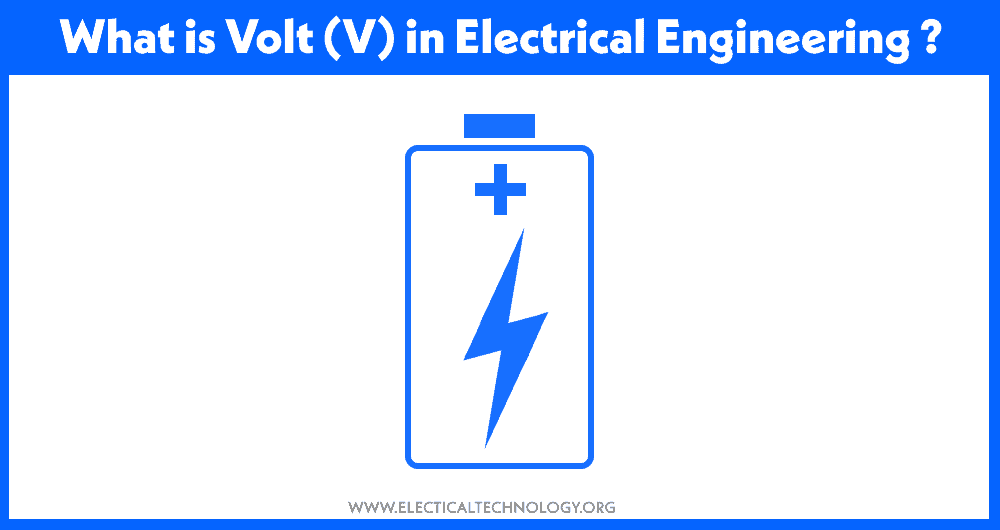What is Volt (V)? Unit of Electrical Potential and Voltage
Volt “V”: Definition, Formula, Measurement, Conversion and Calculation
What is Volt?
A Volt is the derived unit of voltage, electric potential or potential difference and electromotive force (EMF). It is named after the Italian physicist Alessandro Volta (who invented electric battery) and used in physics and electrical and electronics engineering as a derived unit in SI (International System) to measure the voltage and EMF.
The unit of Volt denoted by the symbol of “V” is used to measure the potential or potential difference between two points. A volt is defined as:
If a one joule (J) of energy is utilized to move a one coulomb of charge (C) from one point to another, the value of potential difference between these two points is one volt (V).
Volt = 1 Joule ÷ 1 Coulomb … (V = J ÷ C)
Similarly, it forms the equation in term of energy consumption as follow:
V = W ÷ Q
Where:
- W = Work done in Joule
- V = Volt or Potential difference
- Q = Charge in Coulomb
Relates Posts
- What is Ampere (A)? Unit of Electrical Current
- What is Ohm (Ω)? Unit of Electrical Resistance & Impedance
A volt can be expressed as a pressure which makes possible the flow of electrons in a conducting path such as a conductor or closed electric circuit.
In other words, a volt is expressed as the potential difference between two points which allow the flow of one ampere of current and dissipates one Watt of power during the process between these two points.
V = P ÷ I
V = W ÷ A
Volt = Watt ÷ Amps
Where:
- V = P.D or Voltage
- P = Power in Watts
- I = Current in Amps
According to Ohm’s law, If one ampere of current flows in a resistor having the value of one ohm resistance, the value of potential difference across the resistor will be one volt.
V = I x R
Volt = Amps x Ohms
Where:
- V = Voltage or P.D in Volts
- I = Current in Amperes
- R = Resistance in Ohms (Ω)
Good to know:
The potential difference, or electric pressure (commonly as voltage) is needed to make possible the flow of charge in a conducting material. This electric potential can be obtained from a voltage source like generators and batteries etc.
Volts Equations used for Conversions to the Related Quantities
Volts from Watts and Amps
- V = W ÷ A
- Volt = Watts ÷ Amperes … (V = P ÷ I)
Volts from Joules and Coulombs
- V = J ÷ C
- Volt = Joules ÷ Coulombs
Volts from Amps and Resistance
- V = I x R … (Ohm’s law)
- Volt = Amp x Ohms (Ω)
Volts from Electronvolt & Electron Charge
- V = eV ÷ e
- Volt = Electronvolt ÷ electron charge (e)
Where electron charge “e” = 1.60217662 × 10-19 coulombs
How to Measure Volts?
The tool which is used to measure voltage or volts in a circuit (or potential difference between two points) is known as voltmeter. In both analog and digital multimeters, there is a volt mode for measuring AC and DC voltages. A potentiometer is also used to measure the potential difference between two points.
To measure the voltage in volts across an electrical element such as resistor, capacitor, inductor, diode etc., simply put the two leads of the multimeter (in parallel) and the display will show the exact value of voltage in volts. You may follow the step by step guide posted in the previous article as “How to Measure Voltage using Digital and Analog Multimeter?“.
How to Calculate Volts?
Based on the above given formula and equations for voltage in volts (for different scenarios), we may calculate the value of potential difference in volts as follows.
Example 1:
Find the voltage drop in Volts if the value of flowing current is 2A in a 12Ω resistor.
Solution:
According to Ohm’s law:
V = I x R
Putting the values
V = 2A x 12Ω
V = 24 Volts
Example 2:
Calculate the value of supply Voltage in Volts if 0.5A current is flowing in a 30W light bulb.
Solution:
We know that
V = P ÷ I
Putting the values:
V = 30W ÷ 0.5A
V = 60 Volts
Example 3:
Determine the value of required voltage in volts to glow an LED bulb having 45W and 5Ω resistance.
Solution:
The derived equation from P = V x I where putting I = V ÷ R.
V = √(P x R)
Putting the values:
V = √(45W x 5Ω)
V = √(225)
V = 15 volts.
Example 4:
What is the value of voltage in volts if 50 joules of energy is utilized to move 10 coulombs of charge from one point to another.
Solution:
We know that V = J ÷ C or V = W ÷ Q. Just put the values.
V = 50 Joules ÷ 10 Coulombs
V = 5 Volts
Related Posts:
- What is Voltage? its Unit, Formula, Types & Applications
- What is Electric Current, its Unit, Formula, Types & Applications
- What is Resistance? Resistivity (ρ) & Specific Resistance Ω.
- What is Electrical Power? Types of Electric Power and their Units
- How to Measure Voltage using Digital and Analog Multimeter?
- How to Measure Current using Digital and Analog Multimeter?
- How to Measure Capacitance using a Multimeter?
- How to Measure Frequency using a Multimeter?
- How to Measure Resistance using Digital & Analog Multimeter?
- How to Measure Power using Digital and Analog Multimeter?
- Which One Kills? Current or Voltage and Why? Amps vs Volts
- Difference Between Voltage and EMF?
- Difference Between EMF and MMF
- Difference Between Current and Voltage
- Difference Between Electric Current and Electric Charge








Nice